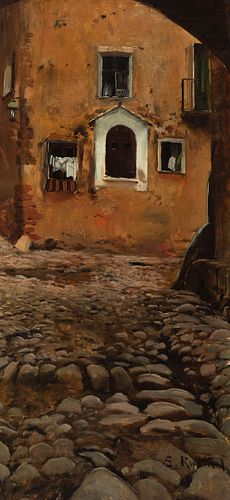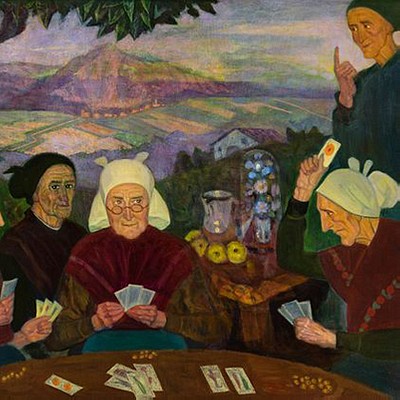SANTIAGO RUSIÑOL I PRATS (Barcelona, 1861 - Aranjuez, Madrid, 1931). "House of peasant. Oil on canvas.
Lot 90
About Seller
Setdart Auction House
Carrer Aragó 346
Barcelona
Spain
Setdart Subastas was born in 2004 and is currently the first online art auction in Spain with solidity, prestige and reliability guaranteed by our more than 60,000 users. Setdart has a young, dynamic and enterprising team ready to successfully manage the purchase and sale of art works through custom...Read more
Estimate:
EUR€18,000 - EUR€20,000
$18,750 - $20,833.33
Absentee vs Live bid
Two ways to bid:
- Leave a max absentee bid and the platform will bid on your behalf up to your maximum bid during the live auction.
- Bid live during the auction and your bids will be submitted real-time to the auctioneer.
Bid Increments
| Price | Bid Increment |
|---|---|
| EUR€0 | EUR€10 |
| EUR€200 | EUR€25 |
| EUR€500 | EUR€50 |
| EUR€1,000 | EUR€100 |
| EUR€3,000 | EUR€200 |
| EUR€5,000 | EUR€500 |
| EUR€10,000 | EUR€1,000 |
| EUR€20,000 | EUR€2,000 |
| EUR€50,000 | EUR€5,000 |
About Auction
By Setdart Auction House
Dec 14, 2021
Set Reminder
2021-12-14 08:00:00
2021-12-14 08:00:00
America/New_York
Bidsquare
Bidsquare : 19th & 20th Century Fine Art
https://www.bidsquare.com/auctions/setdart-auction-house/19th-20th-century-fine-art-7992
Gaudi, Sorolla, Torres Garcia, Maclet, TSUGUHARU FOUJITA, Benjamin Palencia Setdart Auction House sofia@setdart.com
Gaudi, Sorolla, Torres Garcia, Maclet, TSUGUHARU FOUJITA, Benjamin Palencia Setdart Auction House sofia@setdart.com
- Lot Description
SANTIAGO RUSIÑOL I PRATS (Barcelona, 1861 - Aranjuez, Madrid, 1931). "House of peasant. Oil on canvas. Signed in the lower right corner. Measurements: 81 x 40 cm; 96 x 55 cm (frame). From his first youth, Rusiñol was interested in the most remote Catalan landscapes as it shows his trip in carriage that he realized with Ramón Casas by different local towns, taking notes to the natural of types and corners. This farmhouse, framed under a semicircular arch and standing at the end of a pebble path, is proof of this. Later on, the modernist artist would not cease to be interested in painting gardens and solitary corners, as in his series Jardines de España (Gardens of Spain). Painter, writer and playwright in Catalan, Rusiñol was one of the main ideologists of the Catalan modernist movement. He trained as a disciple of Tomás Moragas and frequented the Center of Watercolorists, of which he was one of the founders. He made his debut in 1884 at the Sala Parés in Barcelona, together with his friends Ramón Casas and Enric Clarasó. The year 1888 marks a turning point in his career, since he begins with three new activities: he publishes some writings in "La Vanguardia", participates in the Paris Salon and holds his first individual exhibition at the Sala Parés. The following year, 1889, Rusiñol settles in Paris, in the Montmartre district, with Utrillo, Clarasó and Canudas. He attended the academy of the painter Henri Gervex, and completed his training with Puvis de Chavannes and Carrière. The ruralism he had adopted in Barcelona disappeared, and his style evolved towards naturalism. He also approaches the thematic, but not technical, approaches of the impressionists, as well as their desire to capture a fleeting snapshot. In 1890 he established a relationship with Sitges, where he painted some of his first patios and gardens, a theme that would define his later style. That same year he held his first exhibition at the Sala Parés, together with Casas and Clarasó. In 1890 he returns to Paris with Casas and Utrillo. At this time he will focus on representing the entertainment spaces of the area, such as the Moulin de la Galette, which will be the protagonist of many of his paintings. However, in 1893 he left his studio in Montmartre and moved to the island of Saint Louis, where he focused on the psychological study of the figure, especially female, reflecting the sadness, melancholy and loneliness typical of the fin-de-siècle period. The following year he travels to Italy with Zuloaga, visiting Pisa, Florence and other places, which allows him to know closely the primitives. On his return he exhibits the paintings made during this trip in what will be his first personal exhibition in the Sala Parés. That same year he inaugurates the Cau Ferrat in Sitges, the seed of the current museum. In 1895 he makes his first trip to Granada, and begins the series "Gardens of Spain". He exhibited in Paris at the Salon des Indépendants, at the Exposition Nationale and at the gallery of Samuel Bing, the main promoter of Art Nouveau in France. This last exhibition, of individual character and celebrated in 1899, supposed the international recognition of Rusiñol, whose success was based on a new vision of Spain, totally removed from clichés and loaded with veracity. From then on his activity multiplied as a painter, novelist and comedian, he premiered outstanding works in Madrid and Barcelona and held annual painting exhibitions in the Sala Parés, always with Casas and Clarasó. In 1908 he received the medal of the National Exhibition of Fine Arts. He is represented in the Prado Museum, the National Museum of Art of Catalonia, the Camón Aznar Museum of Zaragoza and the Thyssen-Bornemisza, among others.
- Shipping Info
-
In-house shipping available. Please inquire at admin@setdart.com.
-
- Buyer's Premium



 EUR
EUR CAD
CAD AUD
AUD GBP
GBP MXN
MXN HKD
HKD CNY
CNY MYR
MYR SEK
SEK SGD
SGD CHF
CHF THB
THB















